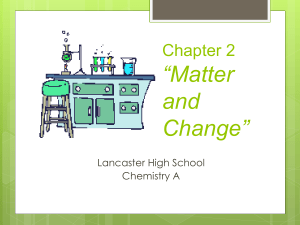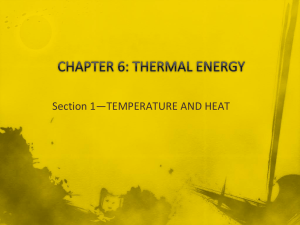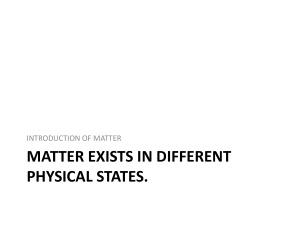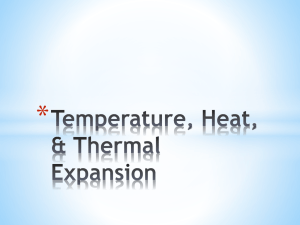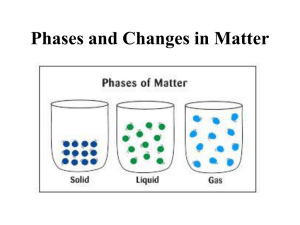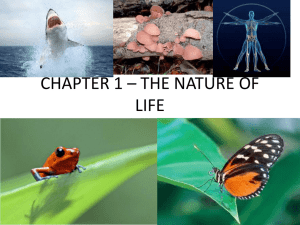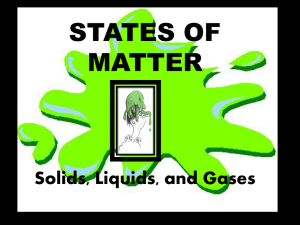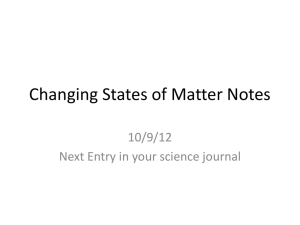Changes in Matter
advertisement
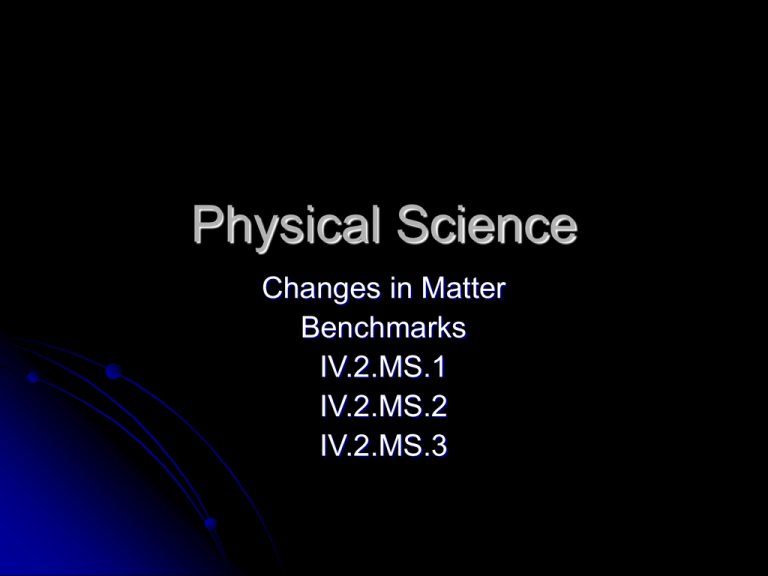
Physical Science Changes in Matter Benchmarks IV.2.MS.1 IV.2.MS.2 IV.2.MS.3 Benchmarks Describe common physical changes in matter: evaporation, condensation, thermal expansion, contraction. (IV.2.MS.1) Describe common chemical changes in terms of properties of reactants and products. (IV.2.MS.2) Explain physical changes in terms of the arrangement and motion of atoms and molecules. (IV.2.MS.3) 3 States of Matter There are 3 major states of matter, they are… Solids Liquids Gasses In all three states of matter, molecules are in constant motion. And yet another phase of matter… Plasma is another phase of matter that is sometimes recognized by scientists. It is a state above the gas phase. Click the link to see another explanation of the states of matter. http://www.chem4kids.com/files/matter_states.html Solids In a solid, relatively strong forces are exerted between the molecules, so the molecules of the material vibrate slowly. Solids, therefore, have a definite shape and volume. Liquids When heat energy is added, the molecules vibrate faster as they absorb the energy. At the melting temperature of the material, the molecules have gained enough energy, so that they can slip and slide past each other. The material is now a liquid. Gasses Liquids still have a definite volume, but take the shape of their container. When more heat energy is added, the motion of the molecules within the liquid increases, until some of the molecules overcome the forces, becoming a gas. The liquid has now evaporated to a gas. The reverse is also true Gas molecules are separated by relatively great distances and move about freely. Gases take the shape and volume of their container. Conversely, when enough energy is lost from gas molecules, they condense into the liquid phase. Condensation Freezing Contract more heat energy less heat energy +E -E States of Matter warmer Plasma colder Gas Liquid Solid (water vapor) (water) (ice) No definite shape No definite shape Definite shape No definite volume Definite volume Definite volume Evaporation Melting Expand BEC Thermal Expansion As a solid is heated, particles move faster and faster and vibrate against each other with more force. As a result, the particles spread apart slightly in all directions and the solid expands. The same effect also occurs in liquids and gases. Thermal Expansion Almost all matter expands as it gets hotter and contracts as it cools. This characteristic of matter is called thermal expansion. This happens because in a solid, forces between the particles hold them together. Thermal expansion Since this phenomenon occurs in bridges, expansion joints allow bridges to expand in warm weather without cracking. Can you imagine the effect that thermal expansion and contraction might have on our roads? Heat and Phases of Matter Heat affects the phases of matter. View this video clip to see how. Introduction There are two types of properties of matter, they are physical properties and chemical properties. There are also two types of changes in matter they are physical changes and chemical changes. Let’s talk about physical properties first. Physical Properties A physical property is any characteristic of a material that one can observe easily without changing the substances that make up the material. Every substance has physical properties that distinguish it from other substances. Physical Properties Physical property examples… shape Size Color Smell Temperature Volume Density melting point boiling point state of matter. Physical Changes A change in physical properties is called a physical change. Physical changes do not alter the identity of a substance. Pounding, pulling, cutting, dissolving, melting, or boiling do not produce a new substance with new properties, so they are all physical changes. Physical Change Example For example if you take a piece of paper and tear it into pieces you still have paper. It may be smaller, but it’s still paper. You could dye the paper and make it another color, but it’s still paper. You have only changed it physically. Physical Changes When trying to identify a physical change, it is important to know that physical changes can be reversed. For example… Pieces of paper can be reformed into a new whole sheet. Ice can be melted, or boiled and then refrozen. Physical Changes of Water Freezing-liquid to a solid; this change requires cooling Melting-solid to a liquid: this change is speeded up by heating. Condensation-gases change to a liquid; this change requires cooling. Vaporization/Evaporation-liquid changes to gas; this change is speeded up by heating. Sublimation-gas changes to a solid or a solid changes to a gas without passing through the liquid state (e.g., dry ice, solid to gas) What Do You Think? Can you name this physical change of water? Here’s a hint: The water is changing from the gas to the liquid phase. What Do You Think? Can you name this physical change of water? Here’s a hint: The water is changing from the liquid to the gas phase. Review Video That was a lot of information. Let’s review physical properties and physical changes with a look at this video clip on states of matter. (18 min) Chemical Properties/Changes Substances can change their identities, for example, fireworks explode, Chemical Properties/Changes matches burn Chemical Properties/Changes Food cooks Chemical Properties/Changes And iron rusts Chemical Properties/Changes Burned toast, burned soup, and burned steak all smell burned. The smell is different from the smell of bread, soup, or steak. The odor is a clue that a new substance has been produced. Chemical Property A chemical property is a characteristic of a substance that indicates if it can undergo a certain chemical change. Click the picture for a video clip about chemical properties. Chemical Change A change of one substance in a material to a different substance is a chemical change. In some chemical changes a rapid production of energy, such as the production of heat, light, sound or gas bubbles occur. These things indicate that a chemical change has occurred. Burning and rusting are chemical changes because different substances are produced. Chemical Change A baked cake no longer resembles its ingredients of flour, eggs, butter, and sugar, because the reactants have undergone a chemical change. product reactants A chemical reaction is simply breaking substances (reactants) apart and making new ones (products) from the pieces. Chemical Changes When trying to identify a chemical change, it is important to know that chemical changes can NOT be reversed. For example… A cake can not be broken down into eggs, sugar, flour, and butter. You can not un burn a piece of wood. Chemical Reactions Those ingredients have been changed by a chemical reaction. A chemical reaction is simply breaking substances (reactants) apart and making new substances (products) from the pieces. Chemical Reactions Whenever a chemical reaction takes place, new substances, the products, are made. These have very different properties from the original starting materials, the reactants. reactant + reactant = product Chemical Reactions This process involves the rearrangement of atoms and molecules, and the making and breaking of chemical bonds. Closed System The mass remains constant, because a chemical reaction is a closed system and no matter is lost. Closed system: a system in which the total mass of each element in the system remains constant before as well as after any kind of chemical or physical change. No matter is ever created or destroyed during the change. Chemical Changes Here’s a video clip that may explain chemical changes more clearly. Physical & Chemical Changes Click the links to hear a science guys song on… Physical Changes Chemical Changes
